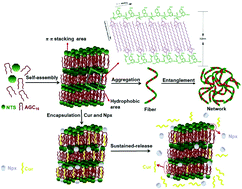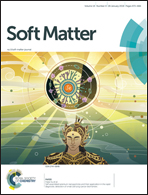A multifunctional supramolecular hydrogel: preparation, properties and molecular assembly
Abstract
A novel supramolecular hydrogel was designed and constructed by molecular self-assembly of a cationic gemini surfactant, 1,3-bis(N,N-dimethyl-N-cetylammonium)-2-propylacrylate dibromide (AGC16), and an anionic aromatic compound, trisodium 1,3,6-naphthalenetrisulfonate (NTS). Owing to its unique structure, the hydrogel (abbreviated as AGC16/NTS) has the potential to be used as a multifunctional drug delivery system. The structure and properties of AGC16/NTS were characterized by rheological measurements, differential scanning calorimetry, variable-temperature 1H nuclear magnetic resonance, ultraviolet-visible spectroscopy, variable-temperature fluorescence emission spectroscopy, cryogenic scanning electron microscopy, transmission electron microscopy and X-ray diffraction methods. The rheological and DSC analysis results revealed that the gel AGC16/NTS was formed below 57 °C. It was found from UV-vis, fluorescence and 1H NMR spectroscopy characterization that aromatic π–π stacking and hydrophobic forces were indispensable to the formation of AGC16/NTS. The Cryo-SEM and TEM observation results indicated that gelators AGC16 and NTS self-assembled into one-dimensional fibers which further tightly intertwined to form a three-dimensional network structure. Based on the spectroscopic data and X-ray diffraction measurement results, a self-assembly model was proposed, helping to further understand the molecular self-assembly mechanism of AGC16/NTS. It was also found that the electrostatic force, hydrophobic force and π–π interaction were the three main driving forces for the gelation. The multiple non-covalent interactions between AGC16 and NTS endowed the hydrogel with excellent performance when the hydrogel was used as a carrier for drug delivery, due to multiple micro-domains within the same gel system. We further investigated the encapsulation and releasing properties of the hydrogel, using the hydrophobic model drug curcumin (Cur) and the model drug naproxen sodium (Npx) with aromatic ring structure. The fluorescence spectroscopy analysis confirmed that Npx was carried through aromatic π–π stacking and the 1H NMR measurement result revealed that Cur was encapsulated within the hydrophobic cavities of AGC16/NTS through hydrophobic interaction. Moreover, the drug release study results showed a sustained release of drugs from the hydrogel, indicating good application prospects in exploring new multifunctional drug delivery systems.



 Please wait while we load your content...
Please wait while we load your content...